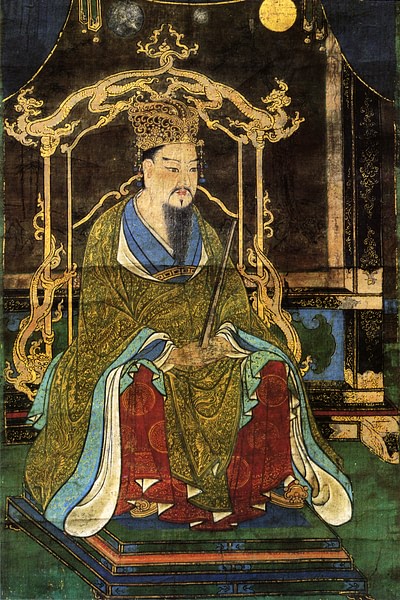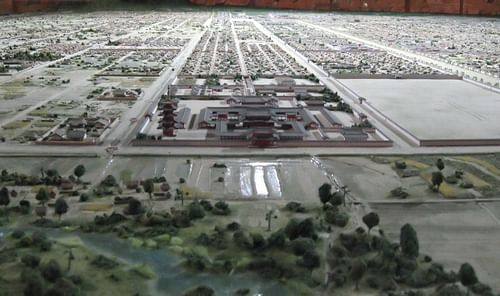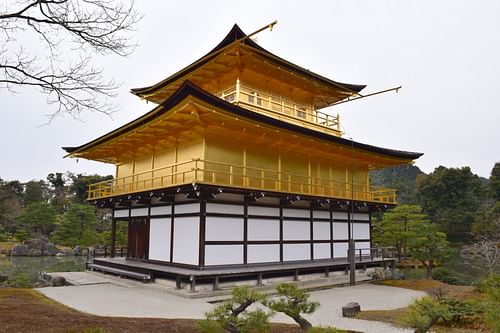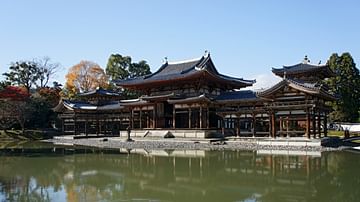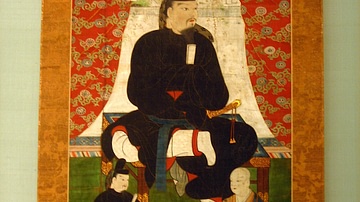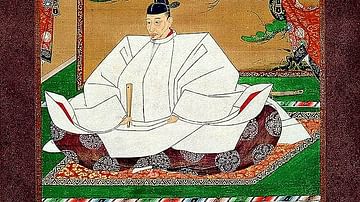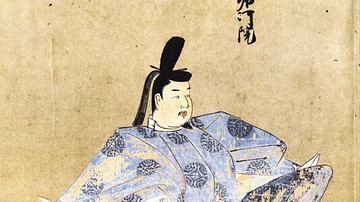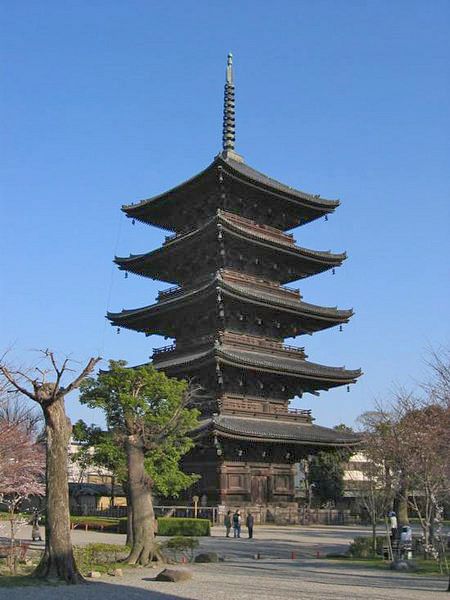
Heiankyo (Kyoto), located in the centre of Honshu island, was the capital of Japan for over a thousand years and gave its name to one of the golden ages of Japanese history, the Heian Period (794-1185 CE). Built according to Chinese design by Emperor Kammu, the city had a huge palace complex, wide avenues, pleasure parks, and many Shinto shrines and Buddhist temples of national importance. Tokyo became the new capital in 1868 CE, but in many ways, Kyoto remains Japan's cultural capital, boasting, for example, 17 UNESCO World Heritage sites in or around its precincts.
Foundation
During the Nara Period (710-794 CE) the Japanese imperial court was beset by rivalries between noble families and an excessive influence on policy from Buddhist sects whose temples were dotted around the capital. Emperor Kammu (r. 781-806 CE), wanting to start afresh, moved the capital from Nara to Nagaokakyo on the Yodo River in 784 CE. However, Nagaokakyo soon gained a reputation as a place of ill luck following various deaths at court, an epidemic, and flood. Kammu, therefore, moved the capital again in 794 CE, this time to Heiankyo. The move marked the beginning of the Heian Period which would last until the end of the 12th century CE.
The site was located on a plain with fertile alluvial soil and rivers which had already been optimised using irrigation techniques. It had also long been a region of rice growing, sake production and silk farming. The mountains in the north and the presence of at least three major rivers meant the site was also good for defence. The climate was, and of course remains, one of the negative features of the city which must bear cold winters, hot summers and a high humidity. Still, spring and autumn were thought especially charming, as this poem from the 11th century CE poet Izumi Shikibu, a lady of the Heiankyo court, reflects:
If only the world
Into spring and fall
We could forever make
And summer and winter
Were never more.
(Whitney Hall, 99)
Layout
Heiankyo means 'the capital of peace and tranquillity,' and it is the name given by Emperor Kammu in an official edict. However, from the 11th century CE, the city's longtime informal name meaning simply 'the capital city' was officially adopted: Kyoto. The city was now the centre of a government which consisted of the emperor, his high ministers, a council of state and eight ministries which, with the help of an extensive bureaucracy, ruled over some 7,000,000 people. The architecture of the city would have to reflect its position as the centre of the Japanese world.
As next to no ancient buildings survive in the city today, its layout and architecture must be reconstructed from surviving 10th-century CE official regulations, 12th-13th-century CE maps, and other textual references. Heiankyo was laid out on a regular grid plan with right angled streets creating regular sized blocks along the Chinese model of the Western Capital at Ch'ang-an (although some historians maintain the model was Fujiwara which copied Nanking).
The city had an 83-metre (270 ft) wide central avenue which dissected the eastern and western quarters, known as Rakuyo and Choan respectively. There were perhaps eight gates around the city although likely no exterior walls to speak of except a short stretch to the south. The city was elsewhere modestly protected by ditches and moats which were spanned by many wooden bridges. The main city gate was the southern Rampart Gate which had two stories, a width of 33.5 metres (110 ft), and reached a height of possibly 21 metres (70 ft).
Running from north to south were some 33 streets and avenues with another 39 streets going from east to west. Most streets measured 10.5 metres (35 ft.) across, and many were lined with thick earth walls and ditches. The 24 avenues of the city were double the width of the streets, and several were around 30 metres (100 ft) across. Such wide streets gave the city an open feel, created many large squares at various intersections, and would have given unobstructed views of the mountains to the north. By the 10th century CE, the city covered a rectangular area measuring some 4.8 km (3 miles) across and 14.5 km (9 miles) in length and boasted a population of between 100,000 and 150,000, some 50,000 of which were employed in the government administration. Heiankyo, then, was undoubtedly one of the great cities of East Asia.
The Royal Palace
The rectangular royal palace complex, known as the Greater Imperial Palace or Daidairi measured around 1.2 x 1.4 km (7% of the city's total area) and was entirely surrounded by a high earth wall with 14 gates, the most important of which was the Vermillion Sparrow Gate. Inside were 200 structures of one kind or another, including palace residence buildings, banquet halls, government offices and storage facilities, Shinto shrines, pagodas, towers, covered walkways, gardens, trees and streams. Architecture followed Chinese models, with the largest building being the Daigokuden or Great Hall of State which contained the imperial throne room. The massive structure, with its green roof tiles, dolphin finials and vermillion pillars typical of all government buildings, measured 53 m (175 ft) by 20 m (65 ft). Burnt down by fire, it was rebuilt on a smaller scale and is today part of the Heian Shrine (see below). Another survivor, albeit reconstructed after another disastrous fire, is the Shishen-den or Audience Hall.
Other Buildings
Outside the palace complex, the aristocracy had palaces with their own carefully landscaped gardens and the Park of the Divine Spring (Shinsen'en) was built south of the Daidairi. This leisure park was 120,000 square meters or 30 acres in area and was dominated by a lake with a banqueting hall for royal ceremonies, the Celestial Presidence Pavillion or Kenrinkaku. Many of the city's streams were diverted and managed to create artificial lakes for the city's parks. There were also dedicated artisan quarters for artists, metalworkers, and potters. Private homes of ordinary folks were, of course, much more modest and had thatch or bark roofs rather than tiles. The wider city also had more government offices, storage buildings, residences for government workers and foreign embassies, an Academy of Chinese Learning (Daigaku-ryo), Buddhist temples, two prisons, and two large markets each the size of four blocks with their own shops, merchant residences, warehouses, and government trade offices.
Important Temples & Shrines
With the emperor wary of undue influence, no Buddhist temples were permitted in the central part of the city and no clergy were permitted to relocate from Nara, although, Kammu did permit the construction of two temples either side of the city's Rashomon gate: the Sai-ji (West Temple) and To-ji (East Temple). The latter was expanded by the famous monk and founder of Shingon Buddhism Kukai in 823 CE and was given its splendid pagoda, Japan's largest and symbol of Kyoto, in 826 CE. The 55-metre (179 ft) tall pagoda burnt down five times but was restored for the last time in 1644 CE. Kammu did not neglect the Shinto religion either and built the important Hirano Jinja shrine in 794 CE. In 859 CE the important Iwashimizu Hachimangu shrine dedicated to Hachiman, the Shinto god of war and culture was built.
The Buddhist Kiyomizu-dera or 'Temple of the Pure Water' was founded before Heiankyo even became the capital, in 778 CE. It was a popular pilgrimage site as believers considered its waters to have healing properties. Fire destroyed many of the buildings, but they were rebuilt in 1633 CE with a new pagoda added. The site is the home of a famous statue of the bodhisattva Kannon by Enchin which is only displayed to the public every 33 years. It is the number one tourist attraction in the city today and a UNESCO World Heritage site.
In 947 CE the remains and literary works of Sugawara no Michizane, aka Tenman Tenjin (845-903 CE), who had been an important court official and who was later deified as the Shinto kami of learning and education, was enshrined at the Kitano Temmangu shrine at Kyoto which was specifically built in his honour.
The Zen Buddhist Kinkakuji temple site, founded in 1397 CE by the shogun Ashikaga Yoshimitsu, includes the famous Golden Pavilion. Yet another victim of fire, the magnificent three-storey Golden Pavilion, with its gilded two top floors, was rebuilt in 1955 CE. It is also a UNESCO World Heritage site.
Other important temples which can be visited today in Kyoto, all of which are UNESCO World Heritage sites, are the Kamigamo Jinja (founded in the 6th century CE), Shimogamo Jinja (also 6th century CE), Ninna-ji (888 CE), Tenryu-ji (1339 CE), Ginkakuji (1460-90 CE), and the Hongan-ji (1591 CE). Finally, the Heian Shrine in Kyoto was founded in 1895 CE on the 1,100th anniversary of the city's foundation as the capital of Japan. It enshrines the kami of the deified Emperor Kammu, the man whose selection set Kyoto off on its road to fame and fortune.
Later History
The city continued to expand through the 11th and 12th centuries CE, especially to the north and east. Unfortunately for posterity, though, next to no ancient buildings survive in Kyoto today. The use of wood panelling and beams, bamboo blinds, and paper walls and screens in ancient Japanese architecture meant that buildings were particularly susceptible to destruction by fire. Almost every decade saw a wave of devastating fires and so parts of the city were constantly being rebuilt. Even those large structures which did survive were regularly rebuilt anyway as part of the Shinto ideal of maintaining clear and pure surroundings, a tradition which continues today in all Shinto buildings, no matter their historical importance.
Although Kyoto remained the capital into the medieval period, its importance was diminished in the Kamakura Period (1185-1333 CE) when the shogunate military rulers took power with their own bases at Kamakura and Edo (Tokyo). Kyoto remained the official capital of Japan through the Edo Period (1600-1868 CE) when several important new buildings were erected including the Nijo Castle by Tokugawa Ieyasu in 1603 CE. Following the Meiji Restoration of 1868 CE, when the emperor was restored, Tokyo was made the new capital. Still, Kyoto continued to enjoy a reputation as Japan's cultural capital even if it was no longer the political one, and even today it is an important cultural centre and a city with many fine (albeit, reconstructed) examples of traditional Japanese architecture.
This content was made possible with generous support from the Great Britain Sasakawa Foundation.
